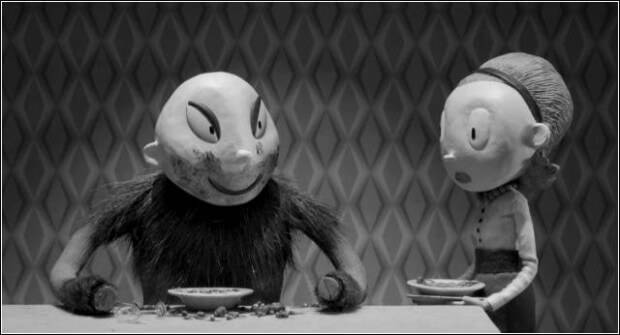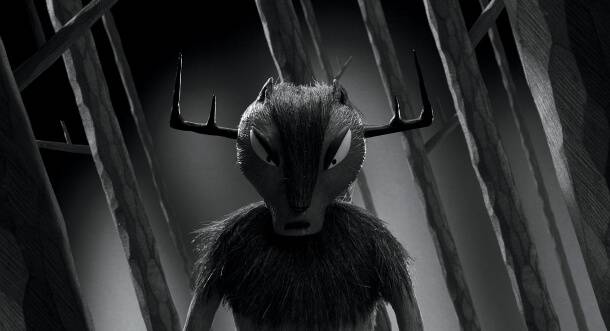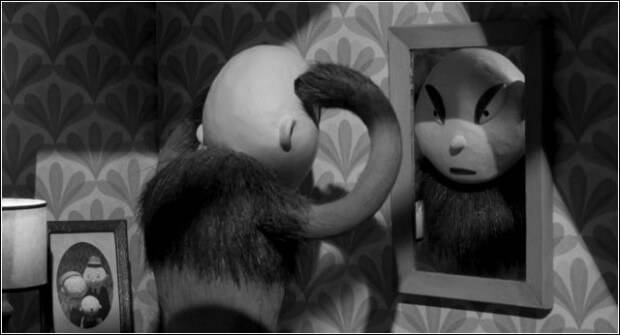Interview with ‘Impostor’ director Elie Chapuis
Doing the festival rounds since spring of last year is Imposteur (Impostor), a wonderful stop motion short from Swiss director Elie Chapuis. The darkly funny short shows a man’s misadventure with a strange wooden beast who is able to deceive his family into accepting him into their happy suburban home. Developed and created at producer Claude Barras’s Hélium Studios, the film uses black and white to express its darker elements as well as paying homage to the noir style of its story and 50s-style set and characters.
Originally created as a comic created by Veronica Da Costa, this head-swapping tale of desire is a must see. We were able to catch up with Elie and discuss the process of making such a fantastical short film.
I understand this is your first solo project, why did you choose to make a film now? And how did the opportunity arise to make this film?
It is indeed my first f
ilm and it took quite a while in development until we got to the final project. Veronica Da Costa came to Hélium Films studios in Lausanne, Switzerland, in 2010 for a few days’ internship. She had brought along a few of her personal works – mostly comics – and I was immediately impressed by Chase, a 3-page black and white comic telling the dialogue-less story of a mad deer stealing the head of many characters in a frenzied chase. It is funny, dark and very radical visually and I quickly saw the potential in adapting it into a film.
Then I was fantastically supported by Claude Barras, my producer and founder of Hélium, and as soon as we found our two French co-producers, a great dynamic was triggered that helped me develop the film as I really wanted and imagined it.
I had wanted to direct my own project ever since before I started to work as an animator, but the writing process is a quite complex phase for me and I had never really developed a decent script for a film. Having a pre-existing story that I really could connect to and base an adaptation upon was a really great start and the visual world of Veronica was full of 1950s references that I really love and included quite faithfully in the final film.
Having also worked on Un Enfant Commode and Sainte Barbe with Cédric Louis could you tell me a little about those films and how that relationship helped in making your own film?
Sainte-Barbe is actually one of my best shooting memories, it was fantastic to animate on. It was all I wish a stop-motion shoot would always be: intense and demanding, very creative, open to some improvisation and fun at the same time. It was a sheer pleasure to work together to make the best film possible. This was also my first professional experience with Claude Barras and Cédric Louis, who co-directed it together. For me it was an opportunity to see authors I admired at work. With all the changes and discussions it was a very open and relaxed way to work.
Un Enfant Commode was a quite different experience since I supervised the animation on it, trying to find a style that would fit a team of relatively junior animators in a technique I was quite new to – After Effects 2D animation. I liked it a lot, even if I think Cédric is really more at ease in stop motion.
Those films of course had an impact in making my own film. I was finishing the last script draft of Impostor as we were finishing the animation of Un Enfant Commode. I had a really nice evening talking with Cédric about the hard times I was going through trying to push my story as far as I could while keeping my original intentions. Cédric then opened up to me about his own doubts and how the writing process can be lonely; It was quite reassuring to see that I wasn’t the only one finding it difficult!
This is basically a film about how a beast cuckolds a man’s wife with a fabulously dark and slightly twisted ending, why did you decide to go with this story?
I think I really liked the different layers this story could have: the beast/human opposition, how the family routine suddenly tips over and the surprises of desire and attraction towards things we never thought we could be attracted to. Some of them were already in Veronica’s comic, some were things that I added without really thinking too much about it.
I think the role of the mother came to the foreground more and more as I was writing, and I think I am quite sensitive to this character and all the archetypes related to it. It was quite funny to then surprise the audience when she suddenly flips and starts to caress the deer. With a few months’ distance I now think this part of the film could have gone a bit further in intensity, but I still love this sequence.
I think family is a very complex place, a microcosm with a lot of untold desires, frustrations and conflicts going back to ancestors that still seem to have influence in the present. Developing a story around an archetypal family and how it is turned upside down is actually something that seemed natural very early in the process. Don’t get me wrong, family is a great place too, full of amazing stories and fundamental experiences.
Who created the puppets? Were they based on your own designs or was it more of a group effort?
The puppets were originally designed by Claude Barras and myself at the drawing stage, and then clay-modeled by Claude. The design was an adaptation of the characters in the comic, except for the deer who drifted away from the naive and quite funny original character. It gained its more edgy, pointy and devilish look in the process.
The clay models from Claude were then developed into puppets at JPL Films in Brittany, one of our two French co-producers. They have an amazing and very experienced team there, making puppets for many years now on a wide variety of projects. Working with them was fantastic from start to finish.
Why did you choose to film it in black and white?
I think it really suited the story since “film noir”and playing with shadows and light is ten times more effective without colours. The comic had this 1950s touch I thought worked so well with the story somehow and keeping it and pushing it further away just seemed the natural thing to do. And yes, to be honest I was a bit afraid of getting lost in colours for my first film.
How long did you have to develop the film, in terms of pre-production, filming and editing?
The development was very long, from late 2010 to end of 2012, mainly because of the writing and storyboarding. There were also complications with the first producer and I was working on other projects at the same time, which slowed things down. The early script and storyboard version was probably a bit too messy and was impossible to fund, but as soon as I had the definitive version of the story the funding was completed in less than six months. We then had one month of set and prop-building early in 2013, one month of painting while the puppets were being built in parallel to all of this. Everything was ready for the shooting in may 2013 and we shot the film during six intense weeks until the end of June 2013.
Post-production took place in France too and lasted the whole summer, as well as the definitive music composing and recording, and the film was eventually mixed in September in Paris. The making of it was pretty short, all things considered.
The film is short and to the point – was that the idea, to create something compact and dynamic?
Absolutely. The film is barely more than six minutes and even that can be very long and boring if the story is not well told. I really wanted something very effective in terms of editing and mise en scène. I think that feature was already there somehow in the original comic; The action has a very nervous cutting in square cases all of the same size, it already creates a strong visual impact when you look at the pages without going further into the story. I wanted to transcribe that feeling into the film.
You also worked on Fantastic Mr. Fox, what was it like to work on a film with such a following from both the Wes Anderson and Roald Dahl fan base?
It was a great experience, of course. But when you work on such a project the days are so full and intense that you never really think about how the film will be perceived when it’s finished. Finishing it already seems sometimes impossible on a daily basis! It’s only towards the end of the shooting, when the whole film starts to appear as a single piece of work and not scattered scenes in a rough edit that you start to see the film you’re really working on, if that makes sense. Of course everyone working on it from the early months of production had a very strong feeling of how visually original the film would be in the end, but in a very diffuse and still imprecise way.
I understand you’re working on a feature as well at the moment, is there anything you can tell us about it? Are there challenges that uniquely arise from working on features than your own short films?
I am indeed working on A Zucchini’s Life (working title for Ma vie de Courgette in French), the first feature film by Claude Barras. It’s a Swiss-French co-production happening in Lyon, France, where the shooting is taking place. It’s an adaptation of the book Autobiography of a Zucchini by Gilles Paris.
I am one of the nine animators on the crew, under the supervision of Kim Keukeleire, a brilliant Belgian animator who animated on Impostor. I think the main challenges of a feature film is really the scale of it and how things can get extremely complicated very quickly. It takes huge organisation, anticipation and planning so that all the pieces of the big puzzle of a stop motion shoot fits together. On Impostor we were shooting on two units at the same time while a third one was being installed. Here it is going to be fifteen units, all having a different set, different lighting atmospheres, different puppets, and I am amazed that it works so well! The film is supposed to come out in theaters at the end of 2015 or beginning of 2016. Keep an eye out for it, it is going to be very original and a contrast to what we have seen recently in stop-motion feature films.
For more information on Impostor and the work of Helium Films visit heliumfilms.ch
Items mentioned in this article:





